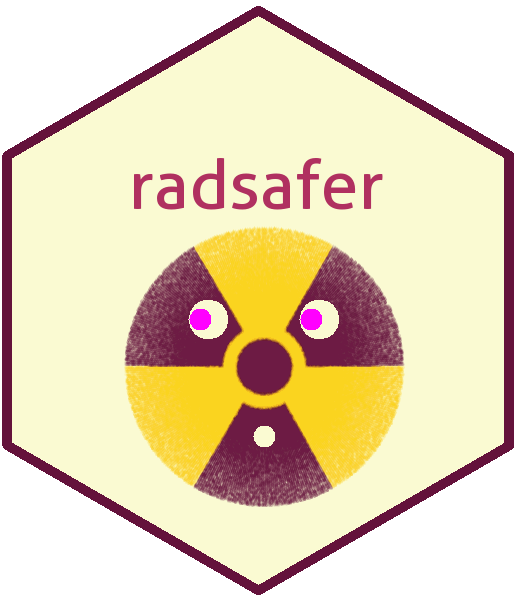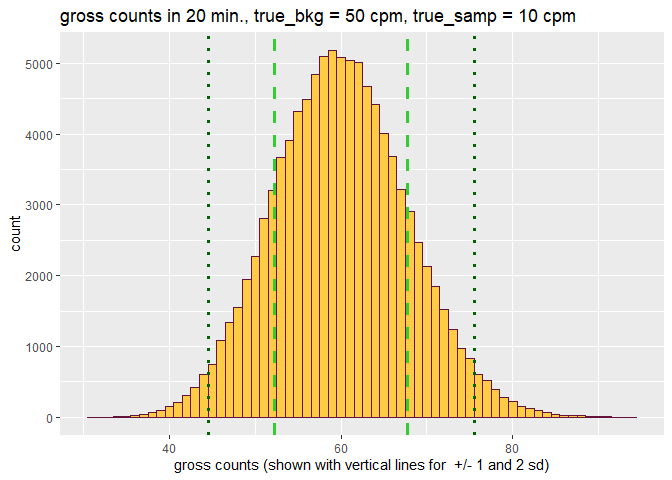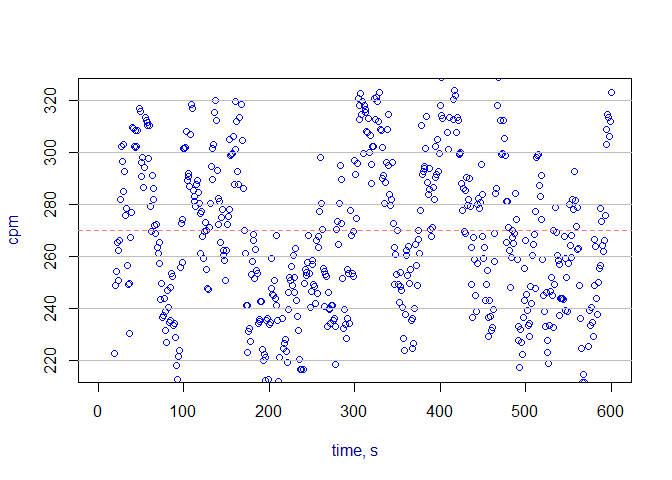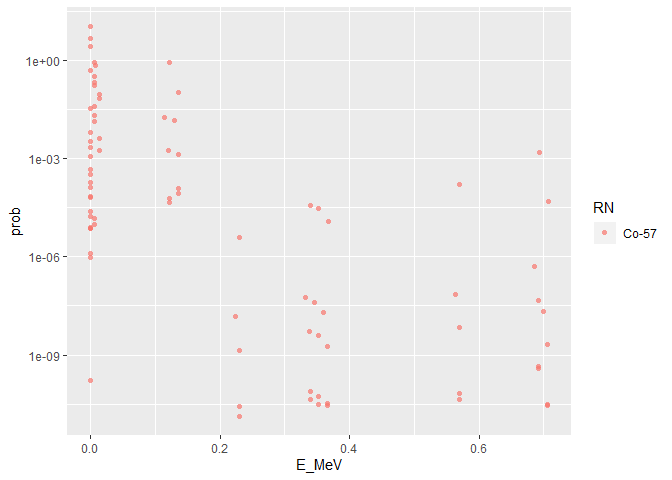

The goal of radsafer is to provide functions that are useful for radiation safety professionals.
You can install the released version of radsafer from CRAN with:
Or install the development version from GitHub:
To start using the installed package:
Radsafer includes several functions to manage radioactive decay corrections:
dk_correct provides decay corrected activity or activity-dependent value, such as instrument response rate or dose rate. The computation is made either based on a single radionuclide, or based on user-provided half-life, with time unit. The differential time is either computed based on dates entered or time lapsed based on the time unit.
Obtain a correction factor for a source to be used today based on a calibration on date1. Allow date2 to be the default system date.
dk_correct(half_life = 10,
time_unit = "y",
date1 = "2010-01-01")
#> half_life RefValue RefDate TargDate dk_value
#> 10 1 2010-01-01 2019-12-17 0.5014729Use this function to correct for the value needed on dates it was used. Let the function obtain the half-life from the RadDecay data. In the example, we have a disk source with an original count rate of 10000 cpm:
dk_correct(RN_select = "Sr-90",
date1 = "2005-01-01",
date2 = c("2009-01-01","2009-10-01"),
A1 = 10000)
#> RN half_life units decay_mode
#> Sr-90 28.79 y B-
#>
#> RN RefValue RefDate TargDate dk_value
#> Sr-90 10000 2005-01-01 2009-01-01 9081.895
#> Sr-90 10000 2005-01-01 2009-10-01 8919.954Reverse decay - find out what readings should have been in the past given today’s reading of 3000
dk_correct(RN_select = "Cs-137",
date1 = "2019-01-01",
date2 = c("2009-01-01","1999-01-01"),
A1 = 3000)
#> RN half_life units decay_mode
#> Cs-137 30.1671 y B-
#>
#> RN RefValue RefDate TargDate dk_value
#> Cs-137 3000 2019-01-01 2009-01-01 3774.795
#> Cs-137 3000 2019-01-01 1999-01-01 4749.991Other decay functions answer the following questions:
How long does it take to decay something with a given activity, or how old is a sample if it has decayed from? dk_time
Given a percentage reduction in activity, how many half-lives have passed.dk_pct_to_num_half_life
Given two or more data points, estimate the half-life: half_life_2pt
air_dens_cf Correct vented ion chamber readings based on difference in air pressure (readings in degrees Celsius and mm Hg):
Let’s try it out combined with the instrument reading:
rdg <- 100
(rdg_corrected <- rdg * air_dens_cf(T.actual = 30, P.actual = 760, T.ref = 20, P.ref = 760))
#> [1] 103.4112neutron_geom_cf
Correct for geometry when reading a close neutron source. Example: neutron rem detector with a radius of 11 cm and source near surface:
disk_to_disk_solid_angle
Correct for a mismatch between the source calibration of a counting system and the item being measured. A significant factor in the counting efficiency is the solid angle from the source to the detector. You can also check for the impact of an item not being centered with the detector.
Example: You are counting an air sample with an active collection diameter of 45 mm, your detector has a radius of 25 mm and there is a gap between the two of 5 mm. (The function is based on radius, not diameter so be sure to divide the diameter by two.) The relative solid angle is:
(as_rel_solid_angle <- as.numeric(disk_to_disk_solid_angle(r.source = 45/2, gap = 20, r.detector = 12.5, runs = 1e4, plot.opt = "n")))
#> [1] 0.045531533 0.002080926An optional plot is available in 2D or 3D:
(as_rel_solid_angle <- as.numeric(disk_to_disk_solid_angle(r.source = 45/2, gap = 20, r.detector = 12.5, runs = 1e4, plot.opt = "3d")))
#> [1] 0.049646801 0.002166732Continuing the example: the only calibration source you had available with the appropriate isotope has an active diameter of 20 mm. Is this a big deal? Let’s estimate the relative solid angle of the calibration, then take a ratio of the two.
(cal_rel_solid_angle <- disk_to_disk_solid_angle(r.source = 20, gap = 20, r.detector = 12.5, runs = 1e4, plot.opt = "n"))
#> mean_eff SEM
#> 0.05418621 0.002261587Correct for the mismatch:
This makes sense - the air sample has particles originating outside the source radius, so more of them will be lost, thus an adjustment is needed for the activity measurement.
scaler_sim
Scaler counts: obtain quick distributions for parameters of interest:

rate_meter_sim
Rate meters: In the ratemeter simulation, readings are plotted once per second for a default time of 600 seconds. The meter starts with a reading of zero and builds up based on the time constant. Resolution uncertainty is established to express the uncertainty from reading an analog scale, including the instability of its readings. Many standard references identify the precision or resolution uncertainty of analog readings as half of the smallest increment. This should be considered the single coverage uncertainty for a very stable reading. When a reading is not very stable, evaluation of the reading fluctuation is evaluated in terms of numbers of scale increments covered by meter indication over a reasonable evaluation period. Example with default time constant:

To estimate time constant, use tau.estimate
Given a dose rate, dose allowed, and a safety margin (default = 20%), calculate stay time with: stay_time
stay_time(dose_rate = 120, dose_allowed = 100, margin = 20)
#> [1] "Time allowed is 40 minutes"
#> [1] 40If you create MCNP inputs, these functions may be helpful:
mcnp_si_sp_RD Obtain emission data from the RadData package and write to a file for use with the radiation transport code, MCNP.
mcnp_si_sp_hist
mcnp_si_sp_hist Or use mcnp_si_sp_hist_scan to quickly copy and paste data interactively.mcnp_matrix_rotations
mcnp_cone_angle
mcnp_plot_out_spec
For MCNP outputs, plot the results of a tally with energy bins. Either first save your data to a text file, or copy and paste it using mcnp_scan2spec.df. Then plot it using your favorite method, or do a quick plot with mcnp_plot_out_spec:
Search by alpha, beta, photon or use the general screen option.
search_phot_by_E allows screening based on energy, half-life, and minimum probability. Also available are search_alpha_by_E, search_beta_by_E, and bin_screen_phot. bin_screen_phot allows limiting searches to radionuclides with emissions in an energy bin of interest with additional filters for not having photons in other specified energy bins. Results for all these search functions may be plotted with RN_plt.
Here’s a search for photon energy between 0.99 and 1.01 MeV, half-life between 13 and 15 minutes, and probability at least 1e-4
| RN | code_AN | E_MeV | prob | half_life | units | decay_constant |
|---|---|---|---|---|---|---|
| Pr-136 | G | 0.99100 | 0.0016768 | 13.10 | m | 0.0008819 |
| Pr-136 | G | 1.00070 | 0.0503040 | 13.10 | m | 0.0008819 |
| Re-178 | G | 1.00440 | 0.0057600 | 13.20 | m | 0.0008752 |
| Pr-147 | G | 0.99597 | 0.0083220 | 13.40 | m | 0.0008621 |
| Xe-138 | G | 0.99680 | 0.0006300 | 14.08 | m | 0.0008205 |
| Nb-88 | G | 0.99760 | 0.0041000 | 14.50 | m | 0.0007967 |
| Mo-101 | G | 1.00740 | 0.0017300 | 14.61 | m | 0.0007907 |
| Sm-140 | G | 0.99990 | 0.0012000 | 14.82 | m | 0.0007795 |

The RN_index_screen function helps find a radionuclide of interest based on decay mode, half-life, and total emission energy.
In this example, we search for radionuclides decaying by spontaneous fission with half-lives between 6 months and 2 years.
RNs_selected <- RN_index_screen(dk_mode = "SF", min_half_life_seconds = 0.5 * 3.153e7, max_half_life_seconds = 2 * 3.153e7)| RN | half_life | units |
|---|---|---|
| Es-254 | 275.7 | d |
| Cf-248 | 334.0 | d |
Other radionuclides family functions:
Provide specific activity RN_Spec_Act
Where did this radionuclide decay from? RN_find_parent